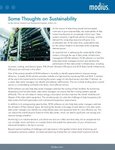Disruption is arguably the technology sector’s key tool, as it utilizes such disruption to cause significant change in an industry by means of innovation.
However, even the technology sector has been unable to shield itself from the ravages of the worst disruptor of recent years; the Covid pandemic.
It should of course be noted that the industry was also able to take advantage of this disruption by enabling and servicing the rise in home working, resulting in the soaring demand for online communications and collaborative software such as Teams and Zoom housed in data centers.
The downside impacts that have been felt however, are largely related to raw material cost inflation, and disruption amongst global supply chains.
Indeed, there is little doubt that these supply chains are continuing to suffer ongoing impacts in the post-pandemic world, exacerbated by geopolitical factors such as the Russian invasion of Ukraine which has led in turn to further economic consequences, not least the rise in energy prices and consequent calculative inflationary effects.
It is within this context that we have sought the views of our European data center participants, 3,500 senior professionals, on a variety of supply chain topics.
Volatility continues
Firstly, there appears to have been little sign of easing on some supply chains, with 86 percent of respondents stating that they had experienced supply chain volatility over the past year, slightly down on the same level who reported the same in winter 2022 but similar to the levels who reported the same one year ago.
Once again, the professionals responsible for delivering new data center facilities to the market have been significantly impacted by the volatility in the supply chain. Our survey of developer/investor respondents revealed that some 91 percent of them confirmed being significantly affected. This figure represents an increase from the 82 percent reported six months ago and 83 percent recorded a year ago.
Notably, among our DEC stakeholders, the impact was more pronounced, with 93 percent expressing their strong agreement, compared to 70 percent in Q4 2022.
Amongst our service providers, there is still a high level of agreement regarding this disruption albeit with some marginal easing; 92 percent stated that they had experienced such supply chain problems, down from 97 percent reported six months ago.
Easier sourcing of some raw materials
In this latest survey, there is some welcome evidence that our build stakeholders are seeing alleviation in problems around their ability to source raw materials used for construction, although not across all items.
For example, issues in the sourcing of dry lining materials have remained relatively static, reported by around a third of respondents whilst the sourcing of cladding has evidently become slightly more problematic, rising from 31 to 34 percent of respondents reporting issues.
However, over the past six months, our respondents have reported an easing of the difficulties in getting hold of other key materials such as steel, where the proportion reporting problems has fallen to 33 percent from 42 percent, and for cement and concrete, down to 27 percent from 38 percent.
But other costs are rising…
Despite this, there is evidence of an inflationary impact on our build professionals, with a rise in associated costs most notable amongst transportation costs as well as construction labor costs. In the case of both, some 80 percent of respondents reported a rise compared to that cited six months ago.
Amongst our developer stakeholders – around 95 percent have reported experiencing rising costs across all three of these metrics, a rise on the 90 percent specifying the same six months ago.
Among all our participants, the acquisition of cooling units and Uninterruptible Power Supply (UPS) hardware has proven to be the most challenging. Regarding the former, approximately 57 percent of participants acknowledged experiencing difficulties in securing this equipment over the past year, while 50 percent stated the same challenges with UPS acquisitions.
Furthermore, two-fifths of the participants encountered similar issues with sourcing power distribution units/components, and an additional third cited difficulties in obtaining switchgear. Just over a quarter of the respondents found it difficult to source lithium-ion batteries and generators.
Impact on future data center locations
In this survey, two-thirds of our respondents stated that ongoing disruptions in the supply chain will significantly impact their decision-making process regarding future data center locations. This represents an increase from the 54 percent recorded in our winter 2022 survey.
Our DEC respondents remain one of the most fervent in agreement, with some 85 percent expressing their agreement albeit a decline from 92 percent recorded six months ago.
In contrast, service providers appear more concerned than previously with 65 percent in agreement, up from the 54 percent previously recorded. Indeed, our integrator participants are now the most heavily in agreement – some 88 percent agreed.
The supply chain (and suppliers) is changing
Most companies have embraced the post-pandemic world by prioritizing the agility and resilience of their supply chains. Amongst respondents, around 60 percent have now looked to source from local or national suppliers, potentially avoiding inflated global transport costs as well as shortening lead-in times.
Around 45 percent have expanded their list of suppliers to give a greater breadth of options, and a similar number have increased order sizes allowing them to carry stock or gain efficiencies from bulk buying.
Around one-quarter of participants have actively changed their supplier or suppliers over the past year in response to disruption.
Amongst our professional groups, just over half of our DEC respondents increased their size of orders to ensure they have access to materials they require, whilst 47 percent of end users and 66 percent of colocation providers looked to increasingly source from local or national suppliers.
Whatever the chosen route, the desired conclusion is the creation of a stronger, more diversified supply chain with greater potential for risk mitigation.
The continuing challenges within the supply chain have pushed data center designers and builders to carefully examine existing supply routes, identifying potential weak points and implementing measures to mitigate associated risks.
This may include consideration around location as well as a significant change in the way they manage their supply chains.








